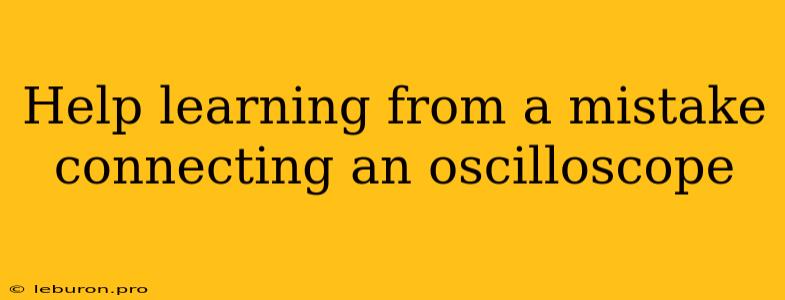Learning from Mistakes: A Case Study of Oscilloscope Connection Errors
Connecting an oscilloscope correctly is a fundamental skill in electronics, but even experienced engineers can make mistakes. These errors can lead to inaccurate readings, damaged equipment, and frustration. The good news is that learning from mistakes is a powerful way to improve your understanding of the equipment and develop better troubleshooting skills. This article will delve into a common mistake encountered when connecting an oscilloscope, analyze its causes and consequences, and provide practical solutions to prevent it in the future.
Understanding the Basics: Oscilloscope Connection
The oscilloscope is a vital tool for visualizing and analyzing electrical signals. It displays voltage as a function of time, providing a detailed picture of the waveform. To utilize this tool effectively, it's crucial to understand the basic principles of connecting it to a circuit.
Essential Components:
- Probe: The probe acts as the interface between the oscilloscope and the circuit under test. It's typically a high-impedance device designed to minimize the impact on the signal.
- Ground Lead: This lead provides a common reference point for the signal being measured. It should be connected to a known ground in the circuit or to a dedicated ground point on the oscilloscope.
- Channel: Each channel on the oscilloscope corresponds to a separate input, allowing simultaneous measurement of multiple signals.
The Common Mistake: Connecting the Probe to the Wrong Point
One of the most common mistakes when connecting an oscilloscope is connecting the probe to the wrong point in the circuit. This might sound simple, but there are various nuances that can lead to misinterpretation of the signal and even damage to the equipment.
Example Scenario:
Imagine you're trying to measure the voltage across a resistor in a simple circuit. You might mistakenly connect the probe to a different component like the capacitor, or even connect the probe to a point in the circuit where there is a large voltage difference, potentially damaging the probe.
Consequences of Wrong Connections:
- Inaccurate Readings: The oscilloscope will display the voltage at the point where the probe is connected, not necessarily the intended signal. This leads to misleading data and incorrect analysis.
- Damage to the Probe: Connecting the probe to a point with a high voltage difference can damage the probe or even the oscilloscope itself.
- Circuit Malfunctions: Incorrect connections can introduce unwanted signals into the circuit, disrupting its normal operation.
Identifying the Error:
The first step in troubleshooting any connection error is to identify the problem. Here are a few common indicators of a misconnected probe:
- Unexpected Waveforms: The signal on the oscilloscope screen doesn't resemble what you expect for the point you're trying to measure.
- Clipping or Distortion: The waveform on the oscilloscope screen is cut off or distorted, indicating that the signal is exceeding the input range of the oscilloscope.
- Excessive Noise: The signal on the oscilloscope screen is very noisy, indicating that the probe is picking up unwanted interference from the circuit.
Solutions to Prevent Future Mistakes:
1. Careful Circuit Analysis: Before connecting the oscilloscope, thoroughly analyze the circuit diagram and identify the specific point where you want to measure the signal.
2. Grounding the Probe: Connect the ground lead of the probe to a known ground point in the circuit or to the oscilloscope's ground terminal. This ensures a common reference point and reduces noise.
3. Probe Placement: Carefully place the probe tip on the desired test point, ensuring good electrical contact.
4. Avoid High Voltage Points: If you're unsure about the voltage at a specific point, use a multimeter to measure it first before connecting the oscilloscope.
5. Understanding the Probe Type: Different probes have different impedance characteristics. Ensure you're using the appropriate type of probe for the circuit you're testing.
6. Verification and Cross-Checking: After connecting the oscilloscope, visually inspect the connections to ensure they are correct.
Learning from Mistakes: A Path to Mastery
Making mistakes is a natural part of learning, especially in a field like electronics. By acknowledging our errors, understanding their root causes, and implementing preventative measures, we can gain valuable insights and improve our skills. Here are some tips for turning mistakes into opportunities for growth:
- Document Your Errors: Keep a log of mistakes you encounter, including the context, symptoms, and solutions. This helps you learn from past experiences and avoid repeating them.
- Engage with the Community: Consult with more experienced colleagues or online forums to discuss the problem and learn from others' experiences.
- Practice and Experiment: Regularly work with the oscilloscope, trying different connections and troubleshooting scenarios. This will help build muscle memory and confidence.
Conclusion
Connecting an oscilloscope correctly is essential for accurate signal analysis. While mistakes can occur, understanding the causes, consequences, and preventative solutions will significantly improve your oscilloscope skills. Remember that mistakes are opportunities for learning, and by actively engaging with the process of troubleshooting and understanding, you'll become a more competent and confident electronics professional.
